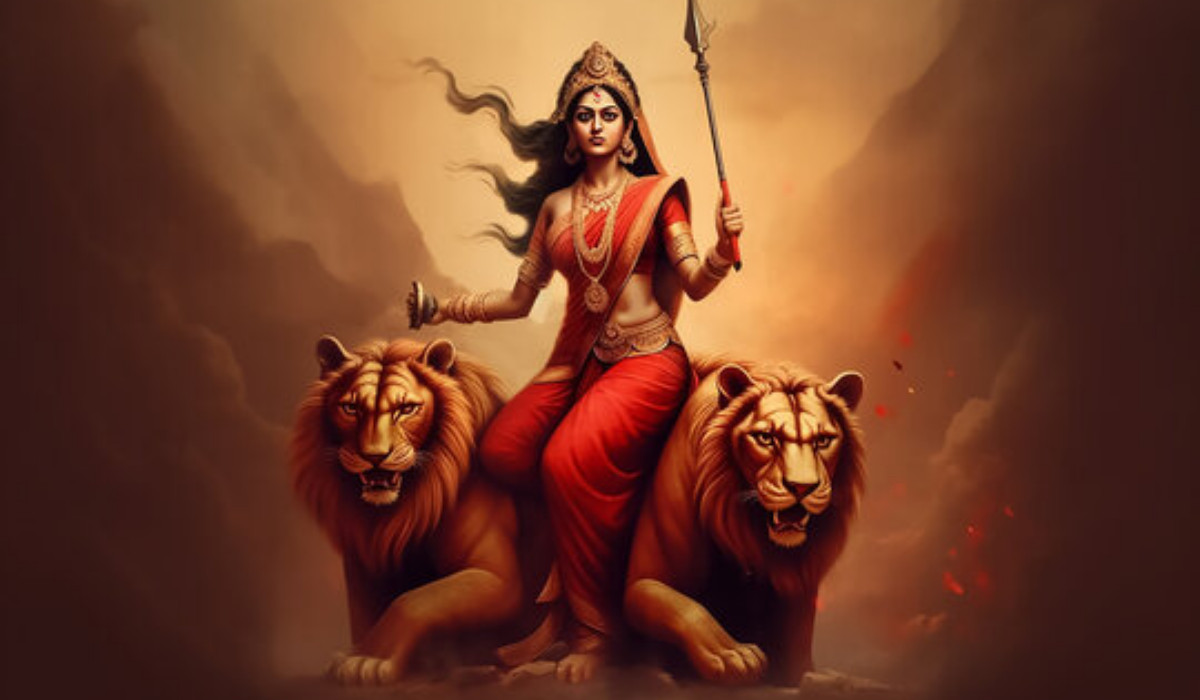Navratri, one of the most vibrant and spiritually significant festivals in India, is celebrated with immense zeal and enthusiasm. This nine-night festival is dedicated to the worship of the goddess Durga and holds deep cultural and religious importance. Each of the nine days signifies a unique facet of the divine and is celebrated with distinct rituals, colors, and customs.
Day 1: Pratipada
On the auspicious occasion of the first day of Navratri, known as Pratipada, devotees gather to pay homage to Goddess Shailaputri, often referred to as the “daughter of the mountains.” This form of the divine embodies nature and purity. She is typically depicted riding a bull, radiating strength and grace. To honor Shailaputri, vibrant orange is the chosen color for this day, symbolizing energy, enthusiasm, and new beginnings. It’s the color of the rising sun, signifying the dawn of a new chapter and the promise of a bright future. Wearing orange on this day is believed to invoke the blessings of Shailaputri, filling one’s life with courage, vitality, and boundless joy.

Day 2: Dwitiya
The second day of Navratri, known as Dwitiya, is dedicated to Goddess Brahmacharini, the embodiment of wisdom and knowledge. She is the epitome of peaceful devotion and spiritual awakening. In her tranquil, white attire, she carries beads and a water pot, signifying her commitment to austerity. White symbolizes purity and peace, as well as the pursuit of knowledge and intellectual enlightenment. By wearing white on this day, devotees invite the blessings of Brahmacharini into their lives, promoting clarity of thought, calmness, and unwavering devotion to the divine.

Day 3: Tritiya
As the third day of Navratri, Tritiya celebrates Goddess Chandraghanta, a symbol of beauty and bravery. This fierce and valiant form of the goddess is often depicted riding a majestic tiger. She radiates confidence and power, making her a force to be reckoned with. To honor Chandraghanta, devotees adorn themselves in fiery red attire. Red is the color of passion, love, and courage. It signifies the intensity of life and the warmth of the heart. Wearing red on this day is a tribute to Chandraghanta, invoking her blessings for unwavering courage, confidence, and an irresistible charisma that leaves an indelible mark.

Day 4: Chaturthi
Chaturthi, the fourth day of Navratri, is dedicated to Goddess Kushmanda, the creator of the universe. She is the source of all creation, radiating strength and grace. In her depiction, she is often seen riding a lion, a symbol of her ferocity and valor. To honor Kushmanda, the color of choice is regal blue. This majestic hue symbolizes dignity, abundance, and creative energy. It represents the vast expanse of the sky and the endless opportunities that life holds. By donning royal blue attire, devotees seek the blessings of Kushmanda, inviting joy, creativity, and a life filled with abundance.

Also Read: Durga Puja: A Celebration of Culture and Heritage Recognized by UNESCO
Day 5: Panchami
The fifth day of Navratri, Panchami, is dedicated to Goddess Skandamata, the mother of Lord Kartikeya, who is often portrayed seated on a lion. Skandamata signifies motherhood and compassion. To honor her, devotees don the vibrant and cheerful color of sunshine yellow. Yellow is associated with happiness, optimism, and the warmth of the sun. It symbolizes the bright and joyful aspects of life, filling one’s heart with hope and positivity. Wearing yellow on this day is an invitation to the blessings of Skandamata, ushering in joy, prosperity, and a harmonious existence.

Day 6: Shashthi
Shashthi, the sixth day of Navratri, is a day dedicated to Goddess Katyayani, a symbol of courage and victory. She rides a lion and radiates a sense of power and bravery. To honor Katyayani, devotees adorn themselves in the soothing and refreshing hue of green. Green symbolizes growth, balance, and the bountiful qualities of nature. It’s a color that reflects fertility and the well-being of the earth. By wearing green on this day, one seeks the blessings of Katyayani, fostering courage, success, and robust health in all aspects of life.

Day 7: Saptami
The seventh day of Navratri, known as Saptami, is dedicated to Goddess Kalaratri, a fierce form representing destruction and liberation. In her depiction, she is often seen riding a donkey, a symbol of her fearless nature. Kalaratri is known for her strength and power, and she is the remover of obstacles. To honor her, devotees choose the color grey. Grey is a mysterious color that signifies subtlety and the enigmatic aspects of life. It represents the vastness of the cosmos and the strength to confront challenges head-on. Wearing grey on this day is believed to invoke the blessings of Kalaratri, providing protection, the ability to let go, and a transformation of one’s life.

Day 8: Ashtami
Ashtami, the eighth day of Navratri, is dedicated to Goddess Mahagauri, the embodiment of beauty and grace. She is depicted riding a bull, symbolizing her calm and composed nature. To honor Mahagauri, devotees opt for the rich and opulent shade of purple. Purple is a color often associated with luxury, grandeur, and nobility. It signifies regal elegance and the pursuit of a life filled with abundance. By donning purple attire, one seeks the blessings of Mahagauri, inviting opulence, richness, and a life characterized by grandeur.

Day 9: Navami
The ninth and final day of Navratri, Navami, is dedicated to Goddess Siddhidatri, the bestower of supernatural powers or siddhis. She is the source of perfection and fulfillment, often depicted riding on a lotus or a lion. To honor Siddhidatri, devotees choose the majestic peacock green, a color that signifies richness, diversity, and the splendor of the natural world. It symbolizes the beauty of nature and its majesty, reflecting the vibrancy of life. Wearing peacock green on this day is an invitation to Siddhidatri’s blessings, ushering in perfection, fulfillment, and enlightenment in one’s life.

Vijayadashami: The Tenth Day
Navratri concludes with Vijayadashami, also known as Dussehra. It is the day when the victory of good over evil is celebrated. In some parts of India, effigies of the demon king Ravana are burned to symbolize the triumph of righteousness.
During Navratri, devotees engage in fasting, prayers, and traditional dances like Garba and Dandiya Raas. The festival is not only a time for spiritual reflection but also a celebration of community, music, and dance. It brings people from all walks of life together to honor the divine and embrace the rich tapestry of Indian culture.
Navratri is a time of devotion, self-discovery, and celebration. It symbolizes the triumph of light over darkness, knowledge over ignorance, and the victory of the divine within us. As each day unfolds, devotees connect with different aspects of the goddess and embark on a profound spiritual journey that leads to Vijayadashami, the ultimate day of triumph and celebration.











